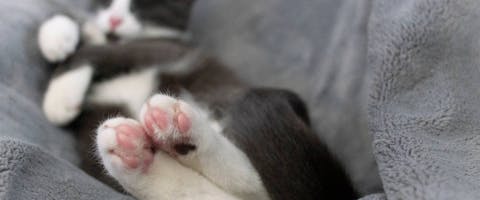Updated 27/02/2024
Those adorable little pink beans that are tucked away beneath our feline friend’s paws might be irresistibly cute, but have you ever wondered what their true purpose is? Today, we’re putting cat toe beans under the microscope as we dive (paw-first) into the world of little pink jelly beans to uncover some fun facts about cat toe beans.
What are toe beans?
To put it simply, cat toe beans are the soft, bean-shaped cushions found on the underside of a cat’s paw. Every cat is a toe beans cat, but the color of these velvety pads varies depending on the melanin in their skin - black cats have black toe beans, cats with calico coats have multi-colored toe beans, and white cats have pink toe beans because they have no melanin.
Here’s an important summary of cats and toe bean color:
- Black cats → black toe beans
- White cats → pink toe beans
- Orange cats → orange toe beans
- Tabby cats → dark red or gray toe beans
- Multi-colored cats → multi-colored toe beans
- Purebred cats → the same color as their nose
Trending posts
Purr-use some of the top blogs our members have been loving this month- Top male dog names for your new furry friendGot a new furry family member in your pack? Check…

- Top female dog names for your new fluffy palWelcoming a new pooch into your family? Explore…

- 250+ gray cat names your silver feline will loveRecently welcomed a fluffy gray bundle of joy into…

- What are normal pet sitting rates?Discover the average pet sitting rates for animals…

- Unique dog names to stand out from the packDare to be different with our list of the best…

Why do cats have toe beans?
We’ll forgive you for thinking those little pink beans are for cute purposes only… but cat toe beans actually have four important roles to play.
- Those soft, cushiony cat paw pads act as shock absorbers, which is part of the reason why your feline friend can jump down from so high and still land on their feet (and we thought it was all down to their nine lives!). This helps kitty cats during hunting and playtime and provides extra stability to ensure they keep their balance.
- They are super sensitive, so they help kitty cats ‘feel’ the ground through their feet. This helps cats to sneak up on prey with stealthy silence, eliminating any clip-clopping sounds that might otherwise come from their claws.
- It’s part of the system that cats use to cool down (cats also regulate their body temperatures by grooming), as our furry felines release extra heat through sweat glands on their toe beans and paw pads.
- Toe beans also contain scent glands which cats use to mark their territories and signal to other furry friends that the area belongs to them. Cats knead their paws to deposit pheromones that communicate a sense of safety in either a particular place or with a specific person (yes - if your cat makes biscuits on you, it’s a sign you make them feel safe and happy).
How many toe beans do cats have?
Cats typically have five toe beans on their front feet and four on their hind paws, that’s a toe-tal of 18 cute little cat toe beans! We say “typically” because if your furry friend is a polydactyl cat, they’ll have even more adorable toes and therefore extra beans - all the better to balance with!
Can cat toe beans fall off?
Fear not pet parents, cat sitters, and all you cat toe bean aficionados - those little pink jewels aren’t going anywhere! Although they’re in no danger of spontaneously falling off, they are extremely sensitive and contain nerve endings that cats use to navigate the world. For this reason, it’s important to keep an eye on your kitty cat’s paws for any signs of injury or infection - cats can be prone to getting debris caught between their kitty toe beans and the skin on their paws can get dry and cracked. Speak to your vet if you have any concerns about your cat’s toe beans and remember that proper paw care ensures that every single adorable toe bean remains happy and healthy.
It’s clear there’s more to these cute little toe beans than what meets the eye, and from acting as shock absorbers to helping to maintain a comfortable body temperature, these adorable jelly beans have a far more important job than simply making us go “aww”.
Meet our veterinary expert, Lizzie
This article has been checked by veterinarian Lizzie Youens BSc (Hons) BVSc MRCVS. Lizzie graduated from the University of Bristol in 2011, and has been working in first opinion companion animal practice. She has worked in a variety of clinics across the UK, from large hospitals to small branch practices. She enjoys doing a mixture of medicine, surgery and emergency work. Lizzie currently works in a small rural practice where she enjoys working in a close-knit community.

